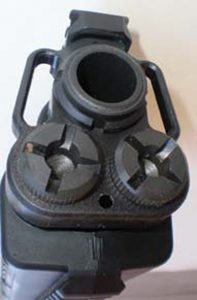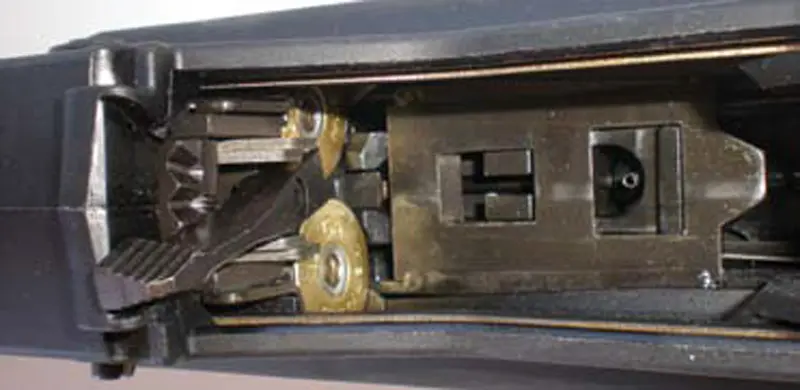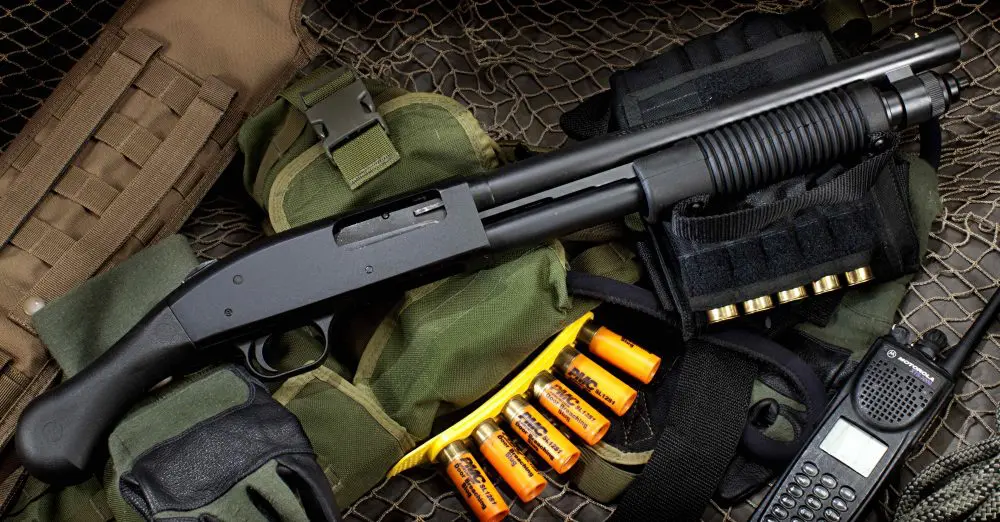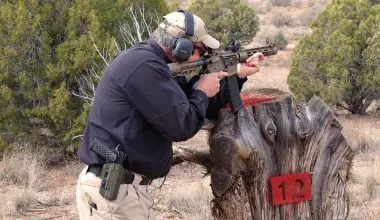

On the next-to-last day of the 2011 SHOT Show, I met up with Louis Awerbuck, who asked me if I had been to the Kel-Tec booth yet. When I told him Kel-Tec was on my list but I had not made it there yet, he said I really needed to check out their bullpup shotgun, which reminded him of the Neostead shotgun. Figuring there was more to this comment than mere South African nationalistic nostalgia on Louis’ part, I redoubled my efforts to get to the Kel-Tec booth.
Table of Contents
NEOSTEAD NS2000
Many years ago, S.W.A.T. Magazine featured an article on the Neostead NS2000. Made in South Africa, the Neostead was a bullpup design that mounted two six-round magazine tubes under a single 22.5-inch barrel with an overall length of 27 inches. A pre-production version with 18-inch barrel was made, but the shorter barrel/ magazine tubes decreased the total capacity to 11 rounds (5+5+1).
The action of the Neostead required that the slide action be pumped forward and then to the rear, in contrast to most slide-actions, which pump to the rear and then forward. I worked with one extensively, but when conducting speed drills I often experienced brain lock, since I had a lot of time behind more traditional shotguns.


KEL-TEC KSG
When I arrived at the Kel-Tec booth, I was immediately intrigued by their bullpup shotgun, the KSG.
Like the Neostead, the KSG utilizes two magazine tubes. However, the KSG uses an 18.5-inch barrel, is even shorter than the Neostead at 26.1 inches, and each magazine of the KSG holds seven rounds instead of six. The KSG also pumps to the rear and then forward in the same manner as other slide-action shotguns that Americans are familiar with. Additionally, the barrel is on top of the twin mag tubes, which equates to less offset when sights are mounted. At first glance, the KSG is definitely an improvement over the Neostead.
The KSG uses a push-button safety above the pistol grip, which is easily manipulated by the thumb (to place on “fire”) and the index finger (to place on “safe”). It is as easy to operate as the safety on a Mossberg shotgun, which is located on the top of the receiver, and much easier than a Remington 870, which is located behind the trigger guard.
The action release lever is ambidextrous, being located on both sides of the trigger guard. The levers also serve superbly as a location to index the trigger finger, keeping it straight and off the trigger.
The magazine tubes feature a threeposition magazine selector. The selector can be used to block both tubes from feeding, or either the right or the left. If the selector is set to the right, the left tube will release shells. If set to the left, the right magazine will release shells. When in the center position, neither magazine will release shells, but the action can be pulled to the rear and a single shell loaded directly into the chamber, such as in a select slug drill or to top the shotgun off with a full 15 rounds.
The ability to easily switch ammunition type at the flip of the selector offers advantages not seen before. While a homeowner may wish to keep both magazines loaded with a shot load, a peace officer might keep one mag loaded with buckshot and the other tube loaded with slugs. Or a team’s breacher could load one tube with breaching rounds and the other magazine with buckshot.
It should go without saying that mixing lethal and less-lethal rounds is a tragedy waiting to happen.
There are three witness slots on each tube to indicate if either mag tube has at least three rounds left. To check if each tube is fully loaded, pull back the forend about an inch—if loaded to capacity, the white follower will be visible.
There are two sling attachment points at the muzzle, and the other end of the sling can be attached at slots at the butt end. The shotgun has a rubber butt pad.
To conduct a chambered round verification (press check), actuate the slide release and pull back the forend about an inch. The shotgun can then be rotated so you can look into the receiver or use the fingers of the weak hand to feel into the receiver for the presence of a chambered round while retaining a firing grip.
On top of the barrel is a foot-long Tmarked Picatinny rail numbered T2 to T30. The forend also has a Picatinny rail, though its slots are not numbered.





SETTING IT UP
The KSG does not come with sights, so it is up to the user to choose iron sights or an optical sight.
I put an Aimpoint PRO on the KSG and found the offset almost identical to when the sight is installed on an AR-15. As mentioned in an earlier article on the Aimpoint (ALWAYS ON, ALWAYS READY: Aimpoint Patrol Rifle Optic, September 2011 S.W.A.T.), the PRO has a battery life of 30,000 hours—three years—on setting seven. Being able to leave this sight on and ready for instant use is a benefit to anyone—military, law enforcement or private citizen— who might need to use his weapon immediately.
I’m a big believer in weapon lights because it is paramount to be able to identify a target as a threat before engaging with lethal force. Anything less is irresponsible.
The light I chose to mount on the KSG was SureFire’s superb M900V. At one time I had M900s on several carbines and was very satisfied with them, but in the past few years they have been replaced with SureFire’s Scout and Mini-Scout lights to lighten the guns. However, the shotgun’s bullpup configuration seemed to lend itself to a vertical foregrip along with the pistol grip. The M900V has a 100-lumen main light and two low-output LED lights for navigation.
With the design of the KSG, if your hand is placed at the rear of the forend, your hand might receive a hard pinch between the forend and the action release while pumping the shotgun (more on this later). The vertical foregrip of the M900V not only prevents the pinch, but also seems to make the action easier to work.
The PRO (with mount) and M900V add 27.8 ounces to the weight of the shotgun, but it feels like much less due to the excellent balance of the bullpup design. The increased weight, however, helps minimize felt recoil and muzzle jump.
I subscribe to the premise that a sling on a long gun is like a holster for a pistol. I attached a Blue Force Gear Victory Sling two-point to the Kel-Tec KSG.
Between the KSG, Aimpoint PRO and SureFire M900V, the shotgun was starting to look like a futuristic weapon in a science-fiction movie.

FIELD EVALUATION
Taking the KSG to the range, the first thing I noticed was how lively the shotgun felt. With an overall length of only 26.1 inches, the balance was very good.
My old standby Remington 870 has an overall length of 39 inches. Equipped with an extended magazine and SureFire dedicated light, most of its weight (and the extra 13 inches) is at the muzzle end. My arms have felt fatigued at the end of Day Two of a threeday shotgun course from supporting the Remington while loading, standing at a ready position, etc. After several days on the range with the KSG, I can honestly say sore muscles would not be a problem with the Kel-Tec shotgun.
I initially ran a light target load (1 ounce, #8 shot) from Federal through the KSG for fam fire. As the shotgun I received for evaluation was a very early production model—with the serial number in the two-digit range—I expected a few hiccups.
On my first short trip to the range, I became somewhat downhearted because my hand was pinched between the end of the forend’s rail and the action release, as mentioned above. I also had six failures to eject out of 15 rounds. I was not impressed.
I did not have the SureFire M900V attached the first time I fired the KSG. When I mounted it, I could not chamber a round at all. The problem? The rear of the light was hitting the action release and not allowing the gun to fully cycle. The unit was moved up two spaces on the rail, which allowed the action to fully cycle and chamber a round.
Then it occurred to me that the gun was not to blame for the initial malfunctions, but they were caused by operator error. I had been inadvertently short-stroking the action by holding the very rear of the foregrip, not fully cycling the action and thus not letting the shells eject—and getting my hand pinched in the process.
Like most males, I don’t read manuals and only occasionally trust the voice coming from my in-vehicle GPS. In all fairness to Kel-Tec, the initial problem would have not occurred if I had only RTFM (read the “friendly” manual) as the manual warned this could happen.
My son Flint and I proceeded to run 150 rounds of birdshot, 30 rounds of buckshot and 15 slugs through the KSG with nary a bobble.
The slugs fired during the evaluation were Federal’s Tactical TruBall® Deep Penetrator slugs (load number LEB127). The TruBall Deep Penetrator slugs use a unique polymer ball that locks the wad and slug in the barrel when fired.
With the intensity of the dot in the Aimpoint PRO turned down to give the illusion of a smaller dot, five-round groups at 60 yards averaged 3.5 inches measured center to center and fired from kneeling. The best five-round group went just a bit over two inches, resulting in a single ragged hole. Not much to brag about with a rifle, but damn good with a shotgun from that distance.
While at a Blackhawk seminar in Bozeman, Montana, back in June, I spoke with Stephen McGrory, Senior Law Enforcement Specialist for ATK. Stephen told me if tight buckshot patterns were desired, I really needed to look at Federal’s Tactical Buckshot with the FLITECONTROL® wad (load number LE132).
Stephen was spot on in regard to tight patterns. At 15 yards, the pattern produced by the KSG with the Tactical Buckshot load with FLITECONTROL wad was just over two inches. At 35 yards—often considered to be outside the maximum effective range of buckshot— all nine pellets struck inside the target’s 9.5×8-inch “kill zone.”
RELOADING
Several folks whom I showed the KSG to during the evaluation posed the question, “How fast can it be reloaded?”
Many peace officers go on duty every day with a Remington or Mossberg carried in “cruiser ready” condition (magazine loaded, empty chamber) with four or five rounds respectively. If they’re lucky, they may have a SideSaddle with an extra six rounds, for a total of 10 or 11 rounds. The KSG beats those numbers by four or five rounds carried cruiser ready. I doubt reloading is much of a realistic consideration with the KSG, but in an emergency, a person could always transition to their pistol and, if a member of a team, would have teammates to cover him.
“OK, but how fast can it be reloaded?”
I found the easiest way to reload the KSG was by letting it hang on the twopoint sling, left side facing outward. This put the loading port just below my sternum and allowed me to look into the port while loading.
With a small amount of practice, and using a Blackhawk shotshell pouch, I was able to load the KSG with 12 rounds in just over 28 seconds. That probably sounds like a lot of time, but round for round it’s actually just slightly longer than it takes to load a conventional shotgun from the same type of pouch.
I had hoped to take the KSG and run it in a shotgun course, but due to scheduling problems, that was not possible.
By the time I’d finished evaluating the shotgun for this article, however, around 400 rounds had been fired through the KSG, which is roughly the equivalent of a Yavapai Firearms Academy shotgun course.
With good ammunition, and outside of the early operator-induced malfunctions, the KSG’s performance has been flawless. The one exception was while using a low-base shot load with silvercolored case heads from Winchester. These loads would stick in the KSG’s chamber and require a lot of force to extract.
Duplicating course conditions, the KSG was not cleaned or babied during the evaluation.
CONCLUSION
The following may not exactly be objective journalism, but it’s hard not to let you know about my unbridled enthusiasm for the KSG—I honestly haven’t been this excited about a gun in years. It has a capacity of 12 gauge ammunition that rivals many 9mm pistols, has excellent balance, ambidexterity, and the test sample was extremely reliable.
I have a lot of years behind traditional shotgun designs, and by nature I’m somewhat of a Luddite, but the Kel-Tec KSG may just make me a believer in change.





